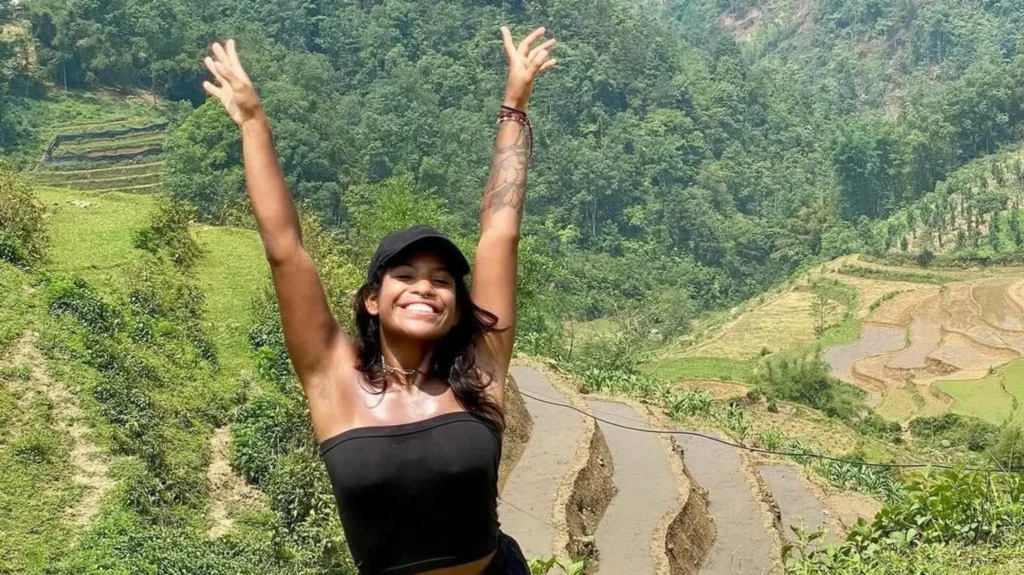A Brazilian tourist, Juliana Marins, 26, was found dead after falling from a cliff during a hike on Mount Rinjani, Indonesia’s second-highest volcano. Marins was trekking with friends and a guide early Saturday when she slipped and plummeted nearly 500 feet down a steep, sandy slope near the crater rim.
Initial drone footage and reports suggested she survived the fall, as rescuers heard her cries for help and spotted her moving below the trail.
However, dense fog, hazardous terrain, and worsening weather severely hampered rescue efforts, preventing teams from reaching her for four days. By the time rescuers arrived, Marins was unresponsive and her death was confirmed by both Indonesian authorities and Brazil’s government.
Marins, a publicist from Niterói, Brazil, had been documenting her travels across Southeast Asia on social media, sharing photos from Vietnam, Thailand, and Indonesia. Her tragic accident has highlighted the dangers of trekking on Mount Rinjani, a popular but challenging destination for tourists due to its steep paths and unpredictable weather.
Local officials noted that Marins did not fall into the volcano’s crater but onto unstable sand, complicating rescue operations. The incident has prompted authorities to temporarily close the Mount Rinjani hiking trail in her memory and for safety reviews.
Mount Rinjani: A Volcanic Giant
Mount Rinjani, standing at 3,726 meters, is Indonesia’s second-highest volcano and a prominent feature on Lombok Island, near Bali. It is an active stratovolcano, formed by the subduction of the Indo-Australian Plate beneath the Eurasian Plate. Rinjani’s geological history is marked by both effusive (lava flows) and explosive (pyroclastic) eruptions, with its most catastrophic event in 1257 believed to have contributed to global climate changes.
The volcano features a massive caldera, Segara Anak, which is partially filled by a deep lake and contains newer volcanic cones like Barujari, the site of most recent activity. Rinjani’s eruptions are typically explosive, with recent events in 2015 and 2016 producing ash plumes that disrupted air travel and local life.
Mount Rinjani is classified as a stratovolcano (or composite volcano), characterized by steep, conical shapes and layers of hardened lava, tephra, and volcanic ash. Stratovolcanoes are known for their powerful, explosive eruptions and can pose significant hazards to climbers and nearby communities.
Preventing Tragedies: Safety Tips for Volcano Trekkers
Mount Rinjani is a popular but challenging trekking destination, attracting thousands of adventure seekers each year. However, its steep slopes, loose volcanic sand, and unpredictable weather make it hazardous. The recent tragedy underscores the importance of strict safety measures:
-Choose Experienced Guides: Always trek with certified, reputable guides who are familiar with the terrain and weather patterns.
-Stay with Your Group: Never separate from your group or guide, especially in difficult or unfamiliar terrain.
-Monitor Weather Conditions: Avoid trekking during adverse weather. Dense fog, rain, and wind can quickly make trails impassable.
-Heed Official Warnings: Pay attention to volcanic activity alerts and trail closures issued by authorities.
-Carry Safety Gear: Ensure you have proper hiking boots, navigation tools, communication devices, and emergency supplies.
-Know Your Limits: Mount Rinjani’s trek is physically demanding. Assess your fitness and experience before attempting the climb.
-Emergency Preparedness: Familiarize yourself with emergency procedures and local rescue contacts.
Juliana Marins’ tragic death is a sobering reminder of the risks involved in volcano tourism, particularly on active and challenging peaks like Mount Rinjani. While the mountain offers breathtaking beauty and adventure, climbers must respect its dangers and prioritize safety at every step
